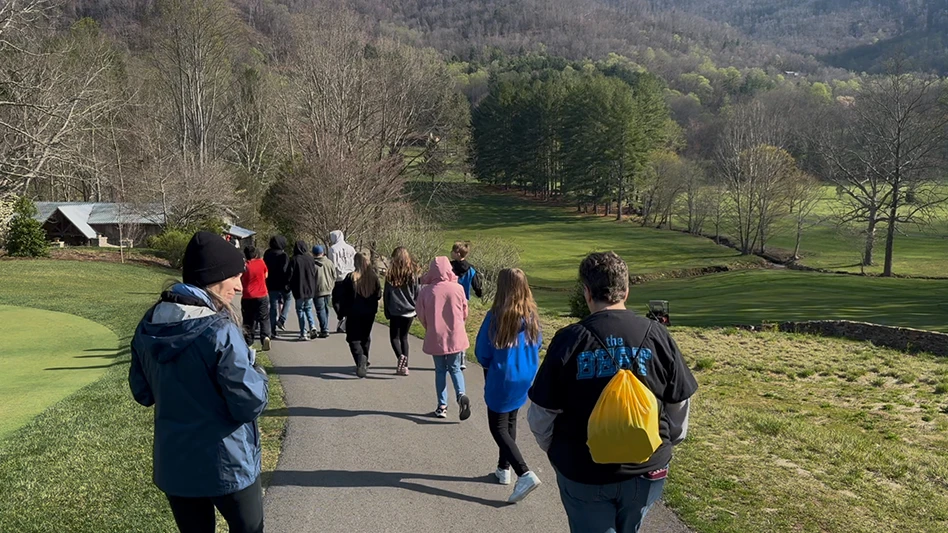 The turf-trial image shows how a PRG program can reduce Poa annua populations in a creeping bentgrass fairway. Photo: SeproBrian Anderson is entering his second decade as superintendent at Nemacolin Woodlands Resort, a 36-hole resort on 2,000 wooded acres in the Laurel Highlands of Southwestern Pennsylvania.
The turf-trial image shows how a PRG program can reduce Poa annua populations in a creeping bentgrass fairway. Photo: SeproBrian Anderson is entering his second decade as superintendent at Nemacolin Woodlands Resort, a 36-hole resort on 2,000 wooded acres in the Laurel Highlands of Southwestern Pennsylvania.
He has used plant growth regulators (PGRs) with solid success on both the predominantly bentgrass Mystic Rocks layout and the mixed-turf links-style course.
Anderson uses a combination of Syngenta’s Trimmit (active ingredient Paclobutrazol) and SePro’s Cutless (active ingredient flurprimidol) PGRs on the newer Mystic Rocks 18, primarily to control troublesome Poa by reducing seed head production, slowing the Poa’s growth and allowing the bentgrass to outgrow the Poa. The PGR combo has allowed Anderson to convert that course from a 50-50, bentgrass-Poa fairway mix to about 95 percent bentgrass. “The bentgrass is really thriving this summer,” the superintendent says.
On the older links layout, Anderson uses SePro’s Legacy, a PGR with flurprimidol and trinexapac-ethyl as active ingredients, that encourage bentgrass growth while suppressing Poa on the greens and fairways.
“It has helped take the mottled look out of the fairways. Legacy has also allowed us to cut down significantly on manpower and create a consistent playing surface. We have increased the percentage of bent there significantly,” the Nemacolin course manager says.
Nemacolin Woods is a solid example of the state of the PGR industry, according to Dr. Cale Bigelow, an associate professor of agronomy at Purdue University. PGRs have been around long enough that superintendents are “tweaking” the formulations to achieve their desired results.
And with the active ingredient Trinexapac-ethyl, the main component of PGR mainstay Primo Maxx recently having come off patent, the cost of PGRs is about half what they were just a few years ago, Bigelow says. “Now superintendents are trying to dial in the combinations,” he says. “For golf course superintendents and sports turf managers, PGRs are important in conditioning playing surfaces. They slow turf growth, reduce clippings and lessen scalping while improving green speeds and consistency.”
In addition to these advantages, PGRs allow maintenance operations to reduce equipment wear, fuel use and hand trimming, improve grass stress tolerance and seed/sod establishment and relocate labor to other projects.
“Instead of doing four to five fairway mowings per week we are able to do just two or three on the fairways using PGRs,” Anderson says. “The savings far outweigh the up-front costs of buying PGRs.”
Using PRGs on The Mystic has cut down on fungicide use at Nemacolin Woods. “We have reduced our pesticides for dollar spot and brown patch by half,” Anderson says. “That is a huge economic benefit. If we can stretch the time between pesticide applications by five to six days, going out every 21 days instead of 14, that saves one or two applications over the course of the season. In this economy anything you can do to drive additional money to the bottom line is helpful.”
Bigelow agrees. “PGRs are important for all courses. Low-price courses use them in the hopes of being able to skip mowings. High-price courses use them to improve conditions.”
In addition to Primo Maxx, Legacy, Cutless and Trimmit, Steve McDonald of Turfgrass Disease Solutions, a Spring City, Pa., consultant, listed PBI Gordon’s ES Embark (active ingredient Diethanolamine salt of mefluidide) and Bayer’s Proxy (Ethephon [(2-chloroethyl)phosphonic acid]) among the best-known PGRs. “Superintendents generally use PGRs from spring green-up through autumn dormancy,” he says. “They have their own specific goals and tweak their application schedules accordingly. Mastering PGR applications is an art.”
Manufacturers offer assistance regarding when and how much product to apply to help them in mastering that art. For example, Rich Hanrahan of Bayer Environmental Science’s Green & Pest Control Northeast, recommends the company’s Proxy brand for Poa annua seedhead suppression be applied at a rate of 5 ounces per 100 sq. ft. of actively growing Poa seedhead in the boot stage (prior to seedhead emergence from the turfgrass plant) with reapplications possible while the seedhead remains in that early-development phase. Proxy should be applied for the first time when daytime air temperatures are 65 degrees and rising, after the turf has been mowed and mowing height established.
Purdue’s Bigelow notes traditional PGR application schedules have moved up from every four to six weeks to simply slow turf growth to as often as every five to seven days in some cases to reduce flush growths and resulting scalping.
As for how late into the season PGRs should be applied, Bigelow says many Northern courses curtail PGR use too early in the fall and should instead continue applications into early November if the cool-season turf is still growing.
The rules-of-thumb are slightly different for Southern courses and warm-season turf, says Todd Bennell, manager of turf and ornamental products/golf market manager for SePro.
Florida Bermudagrass courses, for example, may have to mow three times per week during the summer. Applying a PGR can reduce that to twice per week, Bennell says. “The best time to apply them on Southern courses is May through September. The grass grows so fast you get more scalping and a brown appearance. Scalping can reduce turf health and increase the likelihood of algae appearing on turf.”
Bennell also notes that PGRs provide water savings, an increasingly important characteristic especially in water-strapped Sunbelt states. Some courses can reduce water use as much as 30 percent using PGRs, particularly on fairways that make up 20 to 30 acres on most 18-hole courses.”

Explore the September 2010 Issue
Check out more from this issue and find your next story to read.
Latest from Golf Course Industry
- Ahead of the sustainability curve
- From the publisher’s pen: Watery dilemma
- The Aquatrols Company hires marketing manager
- Renovating Bredemus in West Texas
- Renovation starts at Okatie Creek GC at Sun City Hilton Head
- The Fittest Podcast in Turf: Episode 1
- New 6-hole course debuts in Oklahoma
- GCSAA announces Grassroots Ambassador Leadership Award recipients





